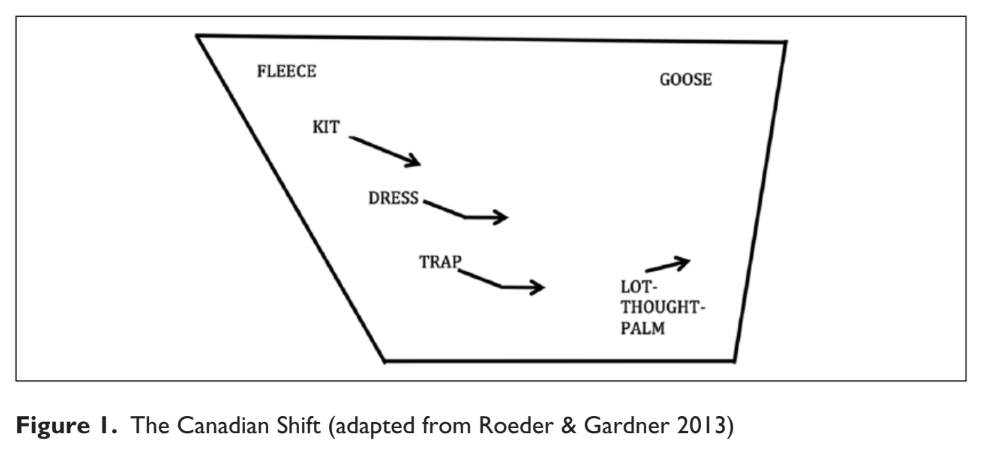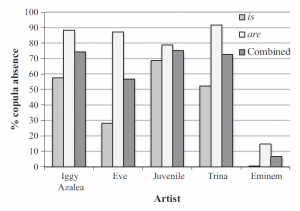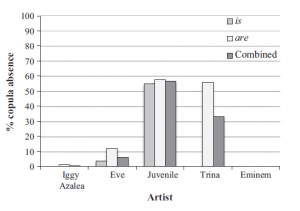One thing that’s always bothered me is the lack of language documentation in rural Canada. Studies of Canadian English represent urban areas. And look, I get it: rural Canadians are spread out thinly across the true north strong and free. Most people live in the urban centers and documenting Canada’s rural dialects would be kind of a big deal. But that means that any claims on “BC English” are about speakers in noVancouver and even though the population of the city is really diverse, linguistics studies there typically aren’t.

Even if these studies were more diverse, we’d be no closer to understanding how people in, like, Fort Nelson speak.
And the thing about that that bothers me is that something like 20% of the population in Canada lives rurally. We don’t know what they sound like or what they’re saying to each other.
All of that’s a rant for another time, but you might understand how excited I was when I can across Rebecca Roeder, Sky Onosson, and Alexandra D’Arcy’s paper (2018) “Joining the Western Region: Sociophonetic Shift in Victoria” which looks at the way some British Columbians who are not Vancouverites talk. While Victoria isn’t exactly rural, it is definitely not Vancouver and sometimes that’s enough.
The Study
The purpose of this study was to try to describe the English in Victoria, BC, something this intrepid trio of scholars has been working on for a long time. They used certain linguistic features to conduct a study of language change over time. The participants were 14-98 years old and from diverse backgrounds.

Speaking of backgrounds, can anyone guess where the first Final Destination was filmed?
Victoria (slash “hi mom!”)
Victoria is sort of a mini Victorian-era England. It’s on what we call The Island, a short ferry ride or flight from Vancouver. It’s an isolated city of around 370,000 people. It was a Hudson’s Bay trading post in 1843 and became a city in 1862. It became the capital of the province in 1971. Private school teachers were imported from England right up to WWII setting the bar for the prestige dialect. And just picture this, I said it was on an island, right? Ya, well it didn’t get regular ferry service to the mainland until 1960. Even though there are now people who commute regularly to the mainland, I have met people who have never been off the island. And I didn’t know this, but the particularly British-y area of Victoria is referred to as the “tweed curtain.” It’s a small, wealthy community with a marina and tea shops (RIP The Blethering Place, tea shop of yore). One would think this modern history of isolation would have some effect on the dialect, no? Well yes, apparently there’s some kind of accent there though its features vary and the population that exhibits them is an aging minority.
Methods
The inquisitive trio used the Synchronic Corpus of Victoria English (SCVE), part of the Victoria English Archive which is comprised of 162 interviews with primarily British-descended Victorians. The speakers range from 1st to 6th generation Victorian (14-98 years old). Some were even related.
For anyone still guessing, maybe “Garrick’s Head” rings a bell
The Sounds
| The Sounds | Wait what? |
Victoria English |
|
The Canadian Shift |
Ok so, the vowels in lit, #blessed, and sass (vowels kit, dress, and trap if you’re new to LinguaBishes) are produced at the same height in the mouth for many English dialects. “Height” refers to where your tongue is when you make a sound. In the Canadian Shift, the vowels in kit, dress, and trap started to lower sometime before 1950. This resulted in a really noticable change among baby boomers. The shift slowed down for Torontonians, but if you’re a Canadian woman under 40, then you might be as much as a generation ahead in the shift than guys you know. | The Shift is more recent in Victoria, perhaps because of its relative isolation. Even though it started later, the youth speak really similarly to other Canadians, which means there was a whole lotta change in a little bit of time. Also because of this late start, older Victorians have higher vowels than their peers across the country. |
 |
||
|
Raising of ban and bag |
Y’all have probably heard, in Canada, we say bag [beɪg] not bag [bæg](same with dragon, wagon, and rag). Also, young Canadians in BC and the prairies do the same thing with ban. (See LinguaBishes Vowel Chart) | In Victoria, ban and bag are at the same place regardless of age or gender. This shows that it’s probably a solid Victorian feature that’s at least eighty-five years old. |
|
Back-Vowel Fronting |
A back-vowel is a vowel that you make with in the back of your mouth. Like in “Karen, that’s some hot goss.” Fronting means making the sounds more towards the front of your mouth. It is very common in British Columbia. | Back-vowel fronting is a systemic process in Victoria. Your goats, your boots, and your foots seem to be pronounced slightly more in the front of the mouth by women. |
| Yod | Yod is the insertion of a y sound before a vowel. Tune is a great example. Yodders (many speakers of British dialects) pronounce the word like tyune or even chyune. In American English, yod is disappearing and in Canada, it is disappearing slower because it is considered prestigious. | Contrary to previous research, this study found yod to be a stable feature in Victoria, but because it is appearing mainly in the word too, it could be another example of back-vowel fronting. |

Results
Our three linguists took their results and compared them to the Phonetics of Canadian English thing (PCE) compiled by Boberg (2008). They examined these features across “apparent time” which basically just means they took the age of the speaker into consideration. Their results were pretty close to Boberg’s PCE, but they found trap to be higher and lot-thought-palm higher and backer like Californian English.
OK, so… ?
After world War II, the English school teachers stopped arriving in Victoria and regular ferry service started. Victoria opened up and experienced a quick population growth. This made is a ripe ground for dialect leveling or “phonological simplification.” This could have been when back-vowel fronting and the vowel shift happened.
And…?
So Victorians, especially young Victorians, mostly speak the same as the majority of western Canadians. Basically anyone under the age of 80 speaks a variety that has leveled out to include the Canadian shift and back-vowel fronting.
BUT the whole aforementioned yod situation shows that Victoria English is holding onto its history. That and the ban/bag raising are hold-outs that were probably unchanged throughout the 20th century. Whereas the low-back merger could have started in Canadian English around 150 years before it got to Victoria. If that’s true, then Canadian English isn’t a single entity that progressed westward during expansion, but a multi-sourced group of dialects. To me, it says we need more surveys of the varieties of BC English from other areas around the province that aren’t Vancouver.

This article is great for phonetics and acoustical analysis bishes, dialect bishes, Canadian bishes, and of course, Final Destination bishes.
Roeder, R., Onosson, S., & D’Arcy, A. (2018). Joining the Western Region: Sociophonetic Shift in Victoria. Journal of English Linguistics,46(2), 87-112. doi:10.1177/0075424217753987
Roeder, Rebecca & Onosson, Sky & D’Arcy, Alexandra. (2015). Simultaneous innovation and conservation: Unpacking Victoria’s vowels.














































